2013 MERCEDES-BENZ B-CLASS SPORTS jump start
[x] Cancel search: jump startPage 8 of 336
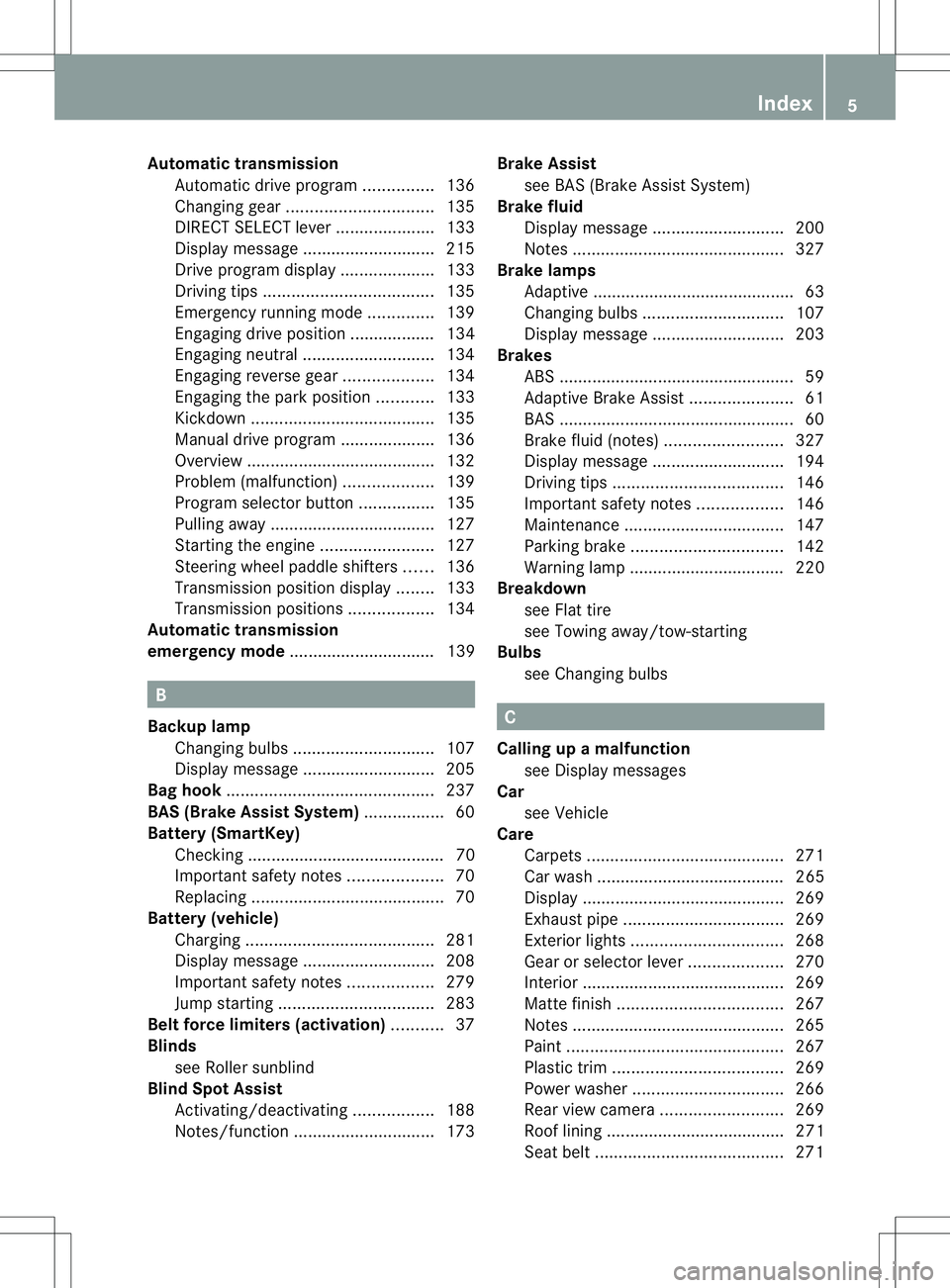
Automatic transmission
Automatic drive program ...............136
Changing gear. .............................. 135
DIRECT SELECT leve r..................... 133
Display message ............................ 215
Drive program displa y.................... 133
Driving tips .................................... 135
Emergency running mode ..............139
Engaging drive position .................. 134
Engaging neutra l............................ 134
Engaging revers egear ................... 134
Engaging the par kposition ............ 133
Kickdow n....................................... 135
Manual drive program ....................136
Overview ........................................ 132
Problem (malfunction) ...................139
Progra mselecto rbutton ................ 135
Pulling away ................................... 127
Starting the engine ........................127
Steering wheel paddle shifters ......136
Transmission position display. .......133
Transmission positions ..................134
Automatic transmission
emergency mode ............................... 139 B
Backup lamp Changing bulbs .............................. 107
Display message ............................ 205
Bag hook ............................................ 237
BAS (Brake Assist System) .................60
Battery (SmartKey) Checking .......................................... 70
Important safety notes ....................70
Replacing ......................................... 70
Battery (vehicle)
Charging ........................................ 281
Display message ............................ 208
Important safety notes ..................279
Jump starting ................................. 283
Belt force limiters (activation) ...........37
Blinds see Roller sunblind
Blin dSpot Assist
Activating/deactivating .................188
Notes/function .............................. 173Brake Assist
see BAS (Brake Assist System)
Brake fluid
Display message ............................ 200
Notes ............................................. 327
Brake lamps
Adaptive .......................................... .63
Changin gbulbs .............................. 107
Display message ............................ 203
Brakes
ABS .................................................. 59
Adaptive Brake Assist ......................61
BAS .................................................. 60
Brake fluid (notes) .........................327
Display message ............................ 194
Driving tips .................................... 146
Important safety notes ..................146
Maintenance .................................. 147
Parking brake ................................ 142
Warning lamp ................................. 220
Breakdown
see Flat tire
see Towing away/tow-starting
Bulbs
see Changing bulbs C
Calling up a malfunction see Display messages
Car
see Vehicle
Care
Carpets .......................................... 271
Car wash ........................................ 265
Display ........................................... 269
Exhaust pip e.................................. 269
Exterior lights ................................ 268
Gea rors electo rlever .................... 270
Interior ........................................... 269
Matte finish ................................... 267
Notes ............................................. 265
Paint .............................................. 267
Plastic trim .................................... 269
Power washer ................................ 266
Rea rview camera .......................... 269
Roof lining ...................................... 271
Seat belt. ....................................... 271 Index
5
Page 12 of 336
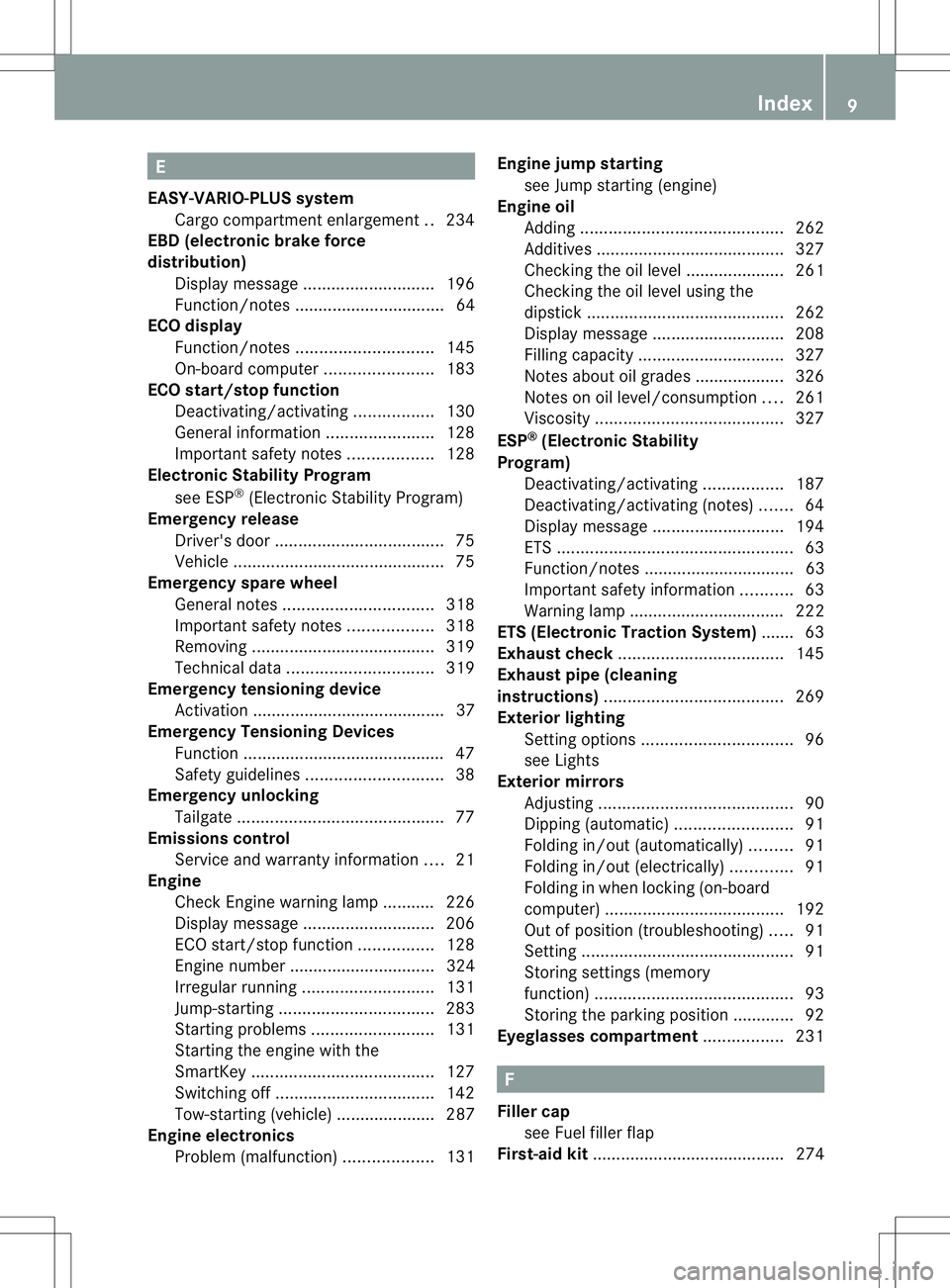
E
EASY-VARIO-PLUS system Cargo compartment enlargement ..234
EBD (electronic brake force
distribution)
Display message ............................ 196
Function/notes ................................ 64
ECO display
Function/notes ............................. 145
On-board computer .......................183
ECO start/stop function
Deactivating/activating .................130
General information .......................128
Important safety notes ..................128
Electronic Stability Program
see ESP ®
(Electroni cStability Program)
Emergenc yrelease
Driver's door .................................... 75
Vehicle ............................................. 75
Emergency spare wheel
General notes ................................ 318
Important safety notes ..................318
Removing ....................................... 319
Technical data ............................... 319
Emergency tensioning device
Activation ......................................... 37
Emergency Tensioning Devices
Function .......................................... .47
Safety guidelines. ............................ 38
Emergency unlocking
Tailgate ............................................ 77
Emissions control
Service and warranty information ....21
Engine
Check Engine warning lamp ........... 226
Display message ............................ 206
ECO start/stop function ................128
Engine number ............................... 324
Irregularr unning............................ 131
Jump-starting ................................. 283
Starting problems ..........................131
Starting the engine with the
SmartKey ....................................... 127
Switching off .................................. 142
Tow-starting (vehicle) ..................... 287
Engine electronics
Problem (malfunction) ...................131Engine jump starting
see Jump starting (engine)
Engine oil
Adding ........................................... 262
Additives ........................................ 327
Checking the oil level ..................... 261
Checking the oil level using the
dipstick .......................................... 262
Display message ............................ 208
Filling capacity ............................... 327
Notes about oil grades ................... 326
Notes on oil level/consumption ....261
Viscosity ........................................ 327
ESP ®
(Electronic Stability
Program) Deactivating/activating .................187
Deactivating/activating (notes) .......64
Display message ............................ 194
ETS .................................................. 63
Function/notes ................................ 63
Important safety information ...........63
Warning lamp ................................. 222
ETS (Electronic Traction System) ....... 63
Exhaus tcheck ................................... 145
Exhaus tpipe (cleaning
instructions) ...................................... 269
Exterior lighting Setting options ................................ 96
see Lights
Exterior mirrors
Adjusting ......................................... 90
Dipping (automatic) .........................91
Folding in/out( automatically).........91
Folding in/out( electrically).............91
Folding in whenl ocking (on-board
computer) ...................................... 192
Out of position (troubleshooting) .....91
Setting ............................................. 91
Storing settings (memory
function) .......................................... 93
Storing the parking position ............. 92
Eyeglasses compartment .................231 F
Fille rcap
see Fuel filler flap
First-aid kit ......................................... 274 Index
9
Page 14 of 336

Hydroplaning
..................................... 149I
Ignition lock see Key positions
Immobilizer .......................................... 65
Indicator lamps see Warning and indicator lamps
Instrument cluster
Overview .......................................... 27
Settings ......................................... 189
Warning and indicator lamps ...........28
Instrument cluster lighting ..............178
Interior lighting ................................. 101
Automatic control ..........................102
Delayed switch-off (on-board
computer) ...................................... 191
Emergency lighting ........................102
Manual control ............................... 102
Overview ........................................ 101
Reading lamp ................................. 101
Interior motion sensor ........................66 J
Jack Storage location ............................ 274
Using ............................................. 313
Jump starting (engine) ......................283 K
Kickdown Driving tips .................................... 135
Manual drive program ....................137
Knee bag .............................................. 42L
Lamps see Warning and indicator lamps
Lane Keeping Assist
Activating/deactivating .................188
Display message ............................ 210
Function/informatio n.................... 174
Lane Tracking package .....................173
LATCH-type (ISOFIX) child seat
anchors ................................................ 51License plate lamp
Changing bulbs .............................. 109
License plate lamp (display
message) ............................................ 204
Light function ,active
Display message ............................ 205
Lights
Activating/deactivating the
interio rlighting delayed switch-off .191
Automatic headlamp mode ..............97
Cornering light function ...................99
Display message ............................ 202
Driving abroad ................................. 96
Fog lamps ........................................ 97
Fog lamps (extended) ....................100
Hazard warning lamps .....................99
High beamf lasher ............................ 99
High-beam headlamps .....................98
Ligh tswitc h..................................... 96
Low-beam headlamps ......................97
Parking lamps .................................. 98
Rea rfog lamp .................................. 98
Standing lamps ................................ 98
Switching Adaptive Highbeam
Assist on/off ................................. 190
Switching the daytime running
lamps on/off (on-board
computer) ...................................... 190
Switching the daytime running
lamps on/off (switch) ......................97
Switching the exterio rlighting
delayed switch-off on/off (on-
board computer )............................ 190
Switching the surround lighting
on/off (on-board computer) ..........190
Turn signals ..................................... 98
see Changing bulbs
see Interior lighting
Light sensor (display message) .......205
Loading guidelines ............................230
Locking see Centra llocking
Locking (doors)
Automatic ........................................ 74
Emergency locking ........................... 75
From inside (central locking
button) ............................................. 74 Index
11
Page 76 of 336
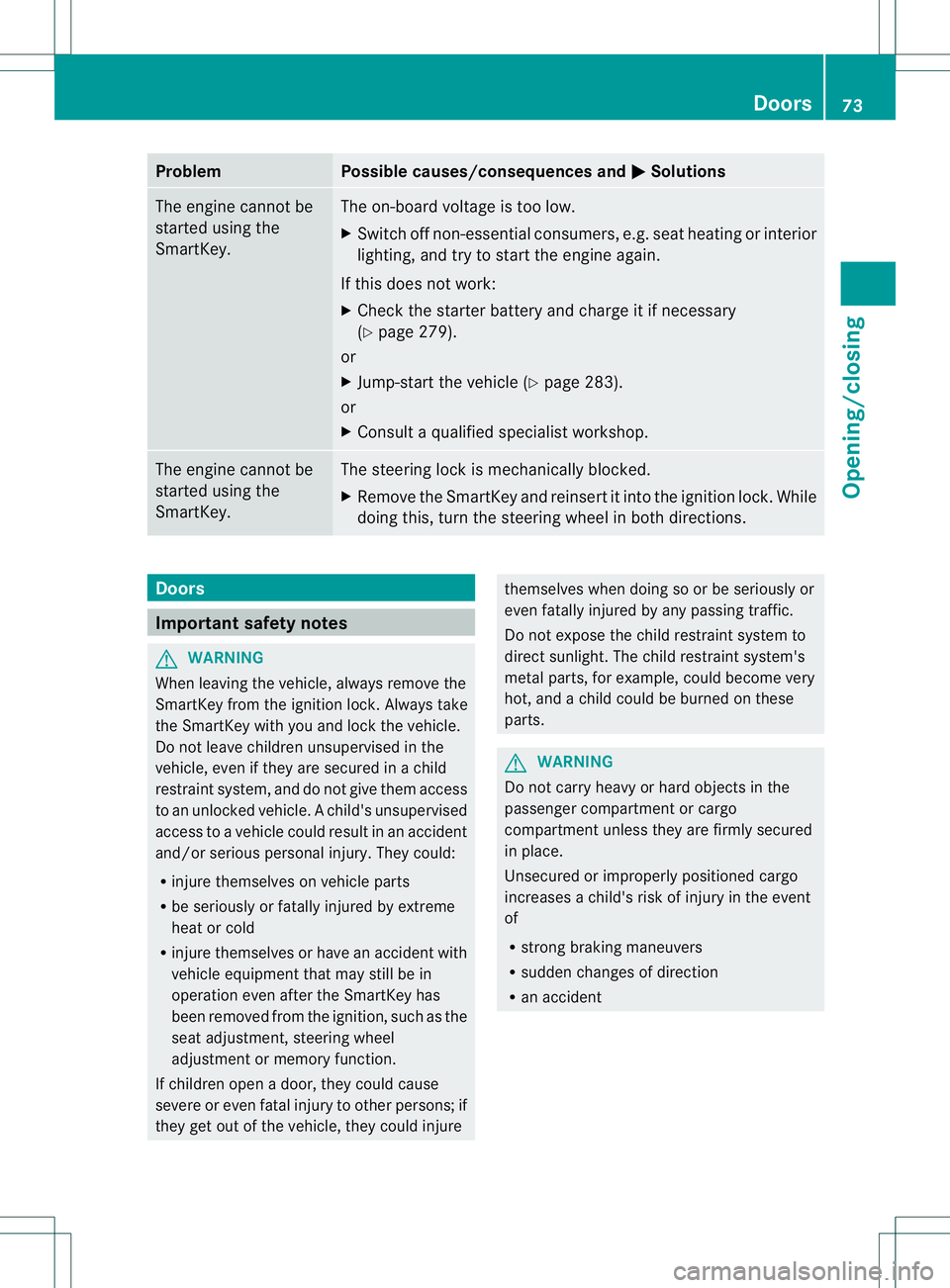
Problem Possible causes/consequences and
M Solutions
The engine cannot be
started using the
SmartKey. The on-board voltage is too low.
X
Switch off non-essential consumers, e.g. seat heating or interior
lighting, and try to start the engine again.
If this does not work:
X Check the starter battery and charge it if necessary
(Y page 279).
or
X Jump-start the vehicle (Y page 283).
or
X Consult a qualified specialist workshop. The engine cannot be
started using the
SmartKey. The steering lock is mechanically blocked.
X
Remove the SmartKey and reinsert it into the ignition lock. While
doing this, turn the steering wheel in both directions. Doors
Important safety notes
G
WARNING
When leaving the vehicle, always remove the
SmartKey from the ignition lock. Always take
the SmartKey with you and lock the vehicle.
Do not leave children unsupervised in the
vehicle, even if they are secured in a child
restraint system, and do not give them access
to an unlocked vehicle. Achild's unsupervised
access to a vehicle could result in an accident
and/or serious personal injury. They could:
R injure themselves on vehicle parts
R be seriously or fatally injured by extreme
heat or cold
R injure themselves or have an accident with
vehicle equipment that may still be in
operation even after the SmartKey has
been removed from the ignition, such as the
seat adjustment, steering wheel
adjustment or memory function.
If children open a door, they could cause
severe or even fatal injury to other persons; if
they get out of the vehicle, they could injure themselves when doing so or be seriously or
even fatally injured by any passing traffic.
Do not expose the child restraint system to
direct sunlight. The child restraint system's
metal parts, for example, could become very
hot, and a child could be burned on these
parts.
G
WARNING
Do not carry heavy or hard objects in the
passenger compartment or cargo
compartmentu nless they are firmly secured
in place.
Unsecured or improperly positioned cargo
increases a child's risk of injury in the event
of
R strong braking maneuvers
R sudden changes of direction
R an accident Doors
73Opening/closing Z
Page 134 of 336
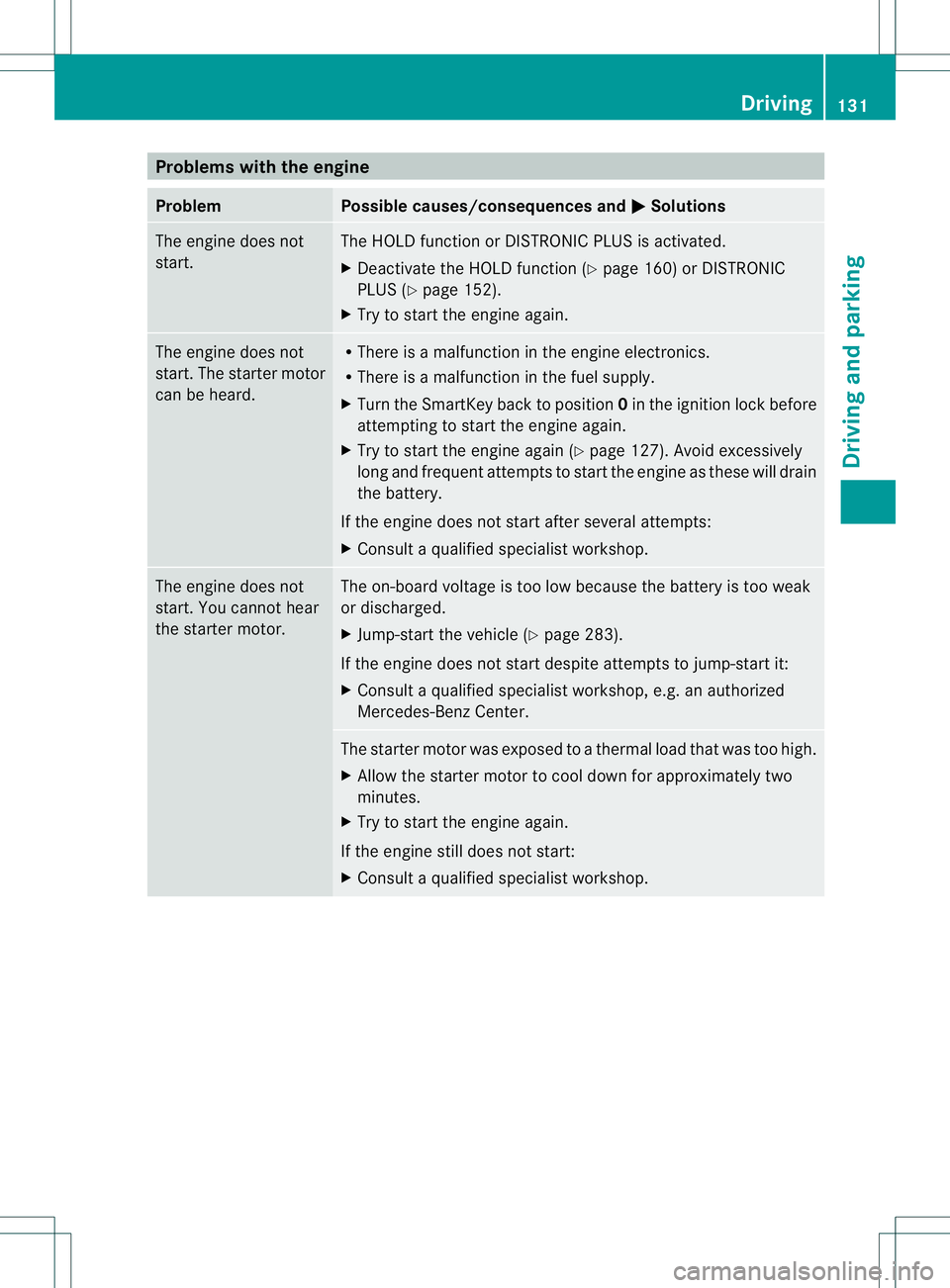
Problems with the engine
Problem Possible causes/consequences and
M Solutions
The engine does not
start. The HOLD function or DISTRONIC PLUS is activated.
X
Deactivate the HOLD function (Y page 160) or DISTRONIC
PLUS (Y page 152).
X Try to start the engine again. The engine does not
start. The starter motor
can be heard. R
There is a malfunction in the engine electronics.
R There is a malfunction in the fuel supply.
X Turn the SmartKey back to position 0in the ignition lock before
attempting to start the engine again.
X Try to start the engine again (Y page 127). Avoid excessively
long and frequent attempts to start the engine as these will drain
the battery.
If the engine does not start after several attempts:
X Consult a qualified specialist workshop. The engine does not
start. You cannot hear
the starter motor. The on-board voltage is too low because the battery is too weak
or discharged.
X
Jump-start the vehicle (Y page 283).
If the engine does not start despite attempts to jump-start it:
X Consult a qualified specialist workshop, e.g. an authorized
Mercedes-Benz Center. The starter motor was exposed to a thermal load that was too high.
X
Allow the starter motor to cool down for approximately two
minutes.
X Try to start the engine again.
If the engine still does not start:
X Consult a qualified specialist workshop. Driving
131Driving and parking Z
Page 276 of 336
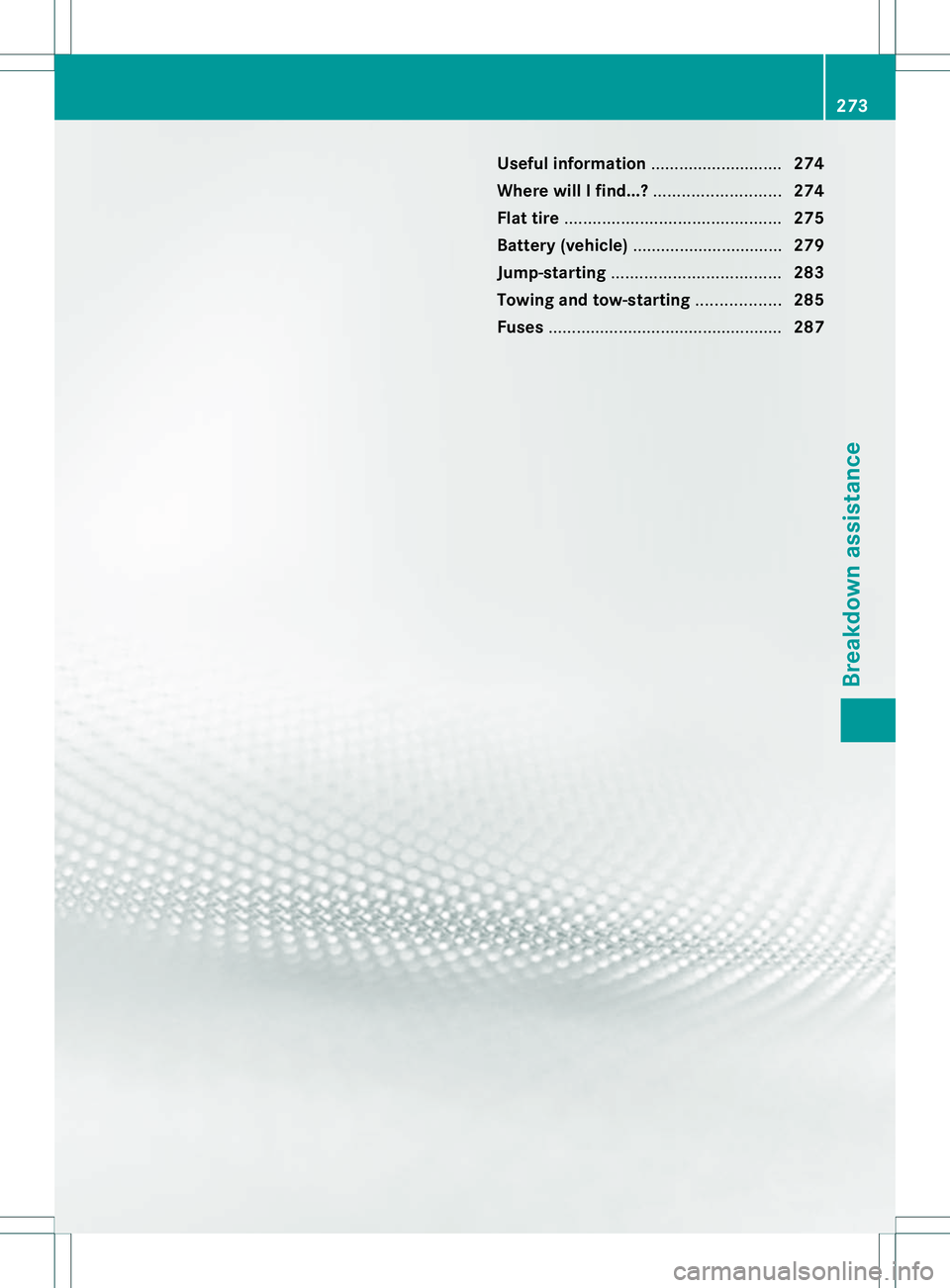
Useful information
............................274
Where will I find...? ...........................274
Flat tire .............................................. 275
Battery( vehicle)................................ 279
Jump-starting .................................... 283
Towing and tow-starting ..................285
Fuses .................................................. 287 273Breakdown assistance
Page 282 of 336
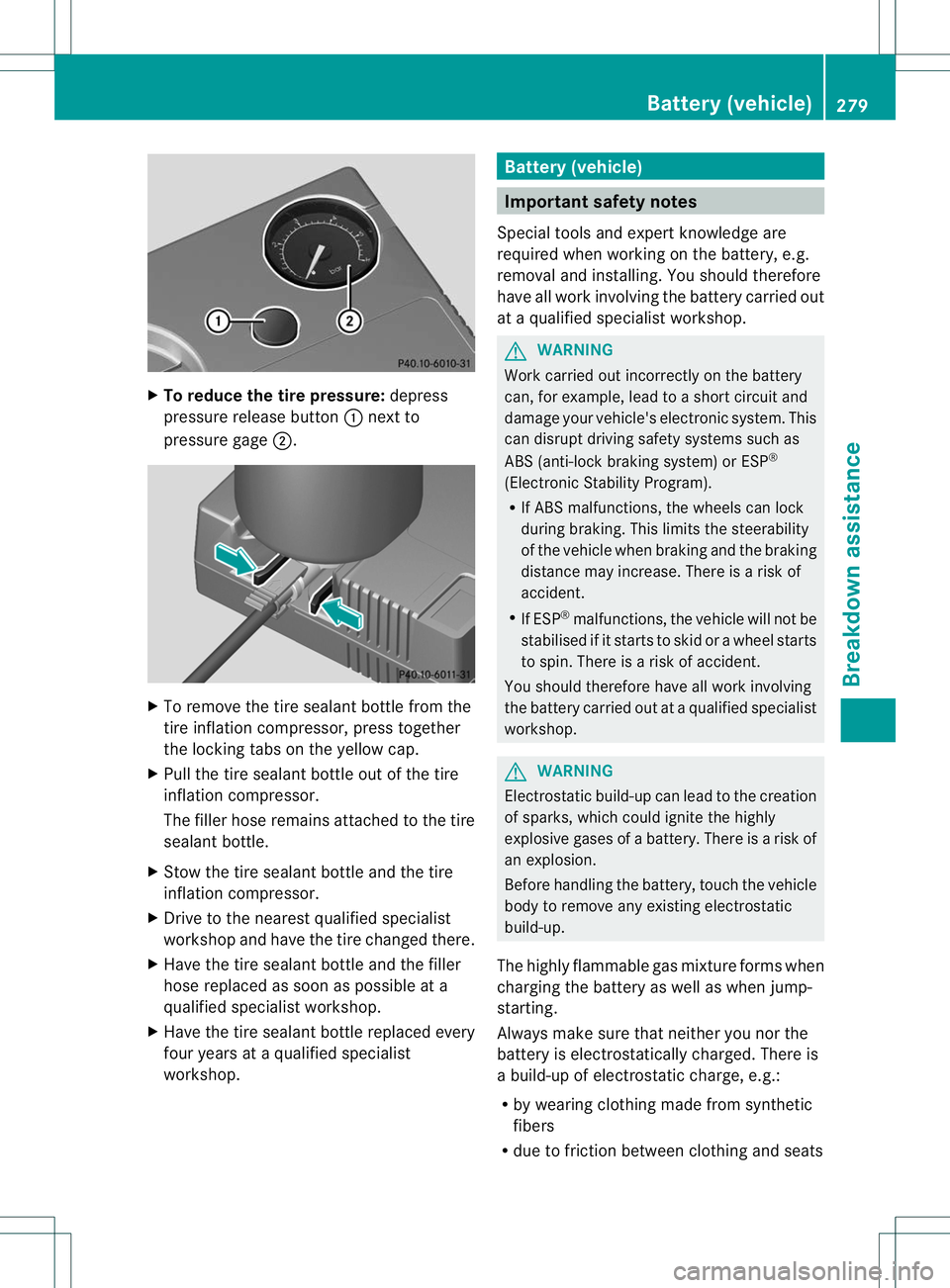
X
To reduce the tire pressure: depress
pressure release button :next to
pressure gage ;. X
To remove the tire sealant bottle from the
tire inflation compressor, press together
the locking tabs on the yellow cap.
X Pull the tire sealant bottle outoft he tire
inflation compressor.
The filler hose remains attached to the tire
sealant bottle.
X Stow the tire sealant bottle and the tire
inflation compressor.
X Drive to the nearest qualified specialist
workshop and have the tire changed there.
X Have the tire sealant bottle and the filler
hose replaced as soon as possible at a
qualified specialist workshop.
X Have the tire sealant bottle replaced every
four years at a qualified specialist
workshop. Battery (vehicle)
Important safety notes
Special tools and expert knowledge are
required when working on the battery, e.g.
removal and installing. You should therefore
have all work involving the battery carried out
at a qualified specialist workshop. G
WARNING
Work carried out incorrectly on the battery
can, for example, lead to a short circuit and
damage your vehicle's electronic system. This
can disrupt driving safety systems such as
ABS (anti-lock braking system) or ESP ®
(Electronic Stability Program).
R If ABS malfunctions, the wheels can lock
during braking. This limits the steerability
of the vehicle when braking and the braking
distance may increase. There is a risk of
accident.
R If ESP ®
malfunctions, the vehicle will not be
stabilised if it starts to skid or a wheel starts
to spin. There is a risk of accident.
You should therefore have all work involving
the battery carried out at a qualified specialist
workshop. G
WARNING
Electrostatic build-up can lead to the creation
of sparks, which could ignite the highly
explosive gases of a battery. There is a risk of
an explosion.
Before handling the battery, touch the vehicle
body to remove any existing electrostatic
build-up.
The highly flammable gas mixture forms when
charging the battery as well as when jump-
starting.
Always make sure that neither you nor the
battery is electrostatically charged. There is
a build-up of electrostatic charge, e.g.:
R by wearing clothing made from synthetic
fibers
R due to friction between clothing and seats Battery (vehicle)
279Breakdown assistance Z
Page 283 of 336
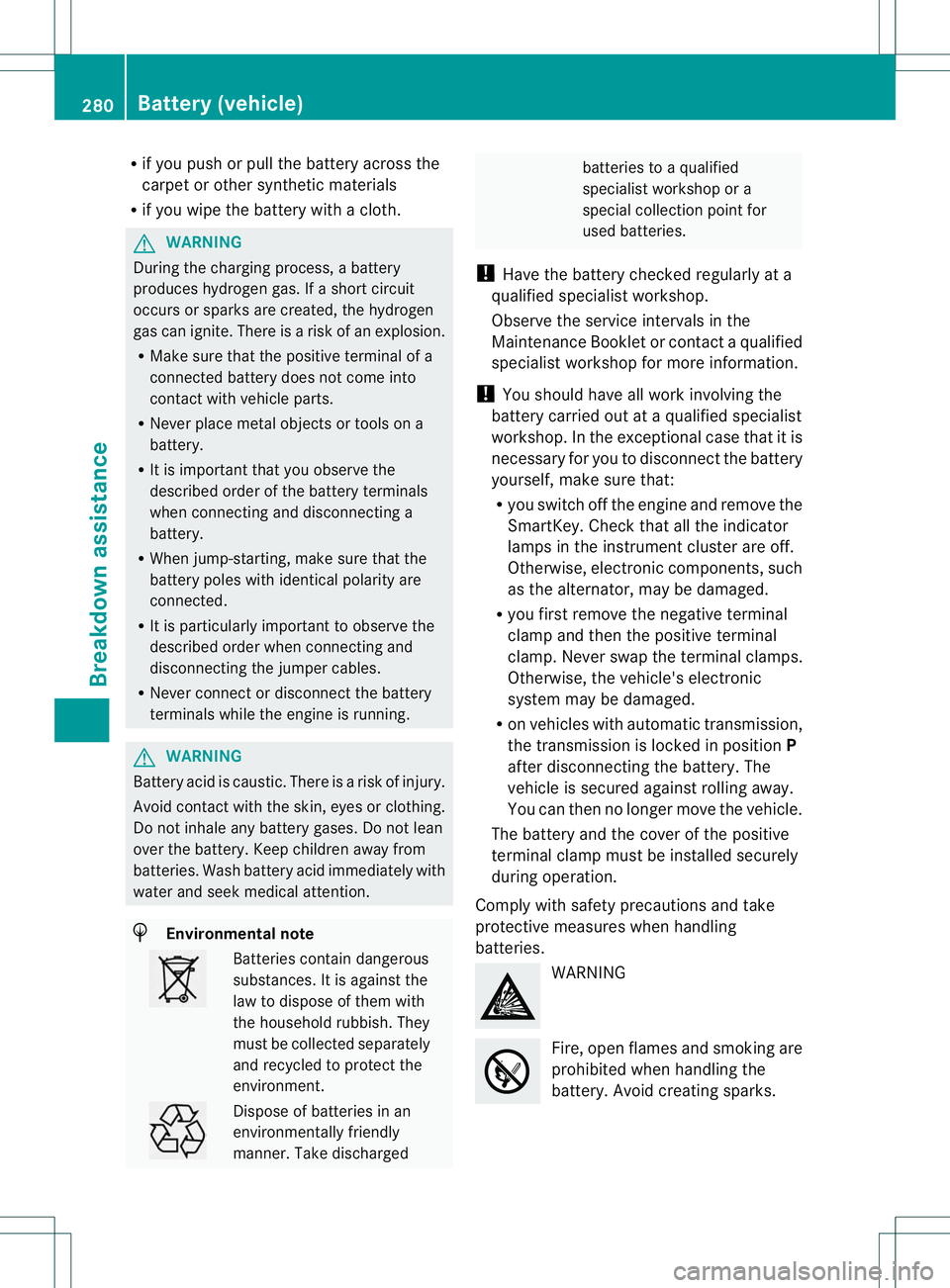
R
if you push or pull the battery across the
carpet or other synthetic materials
R if you wipe the battery with a cloth. G
WARNING
During the charging process, a battery
produces hydroge ngas. If a shor tcircuit
occurs or sparks are created, the hydrogen
gas can ignite. There is a risk of an explosion.
R Make sure that the positive terminal of a
connected battery does not come into
contact with vehicle parts.
R Never place metal objects or tools on a
battery.
R It is important that you observe the
described order of the battery terminals
when connecting and disconnecting a
battery.
R When jump-starting, make sure that the
battery poles with identical polarity are
connected.
R It is particularly important to observe the
described order when connecting and
disconnecting the jumper cables.
R Never connect or disconnect the battery
terminals while the engine is running. G
WARNING
Battery acid is caustic. There is a risk of injury.
Avoid contactw ith the skin, eyes or clothing.
Do not inhale any battery gases. Do not lean
over the battery. Keep children away from
batteries. Wash battery acid immediately with
water and seek medical attention. H
Environmental note Batteries contain dangerous
substances. It is against the
law to dispose of themw
ith
the household rubbish. They
must be collected separately
and recycled to protect the
environment. Dispose of batteries in an
environmentally friendly
manner. Take discharged batteries to a qualified
specialist workshop or a
special collection point for
used batteries.
! Have the battery checked regularly at a
qualified specialist workshop.
Observe the service intervals in the
Maintenance Booklet or contactaqualified
specialist workshop for more information.
! You should have all work involving the
battery carried out at aqualified specialist
workshop. In the exceptional case that it is
necessary for you to disconnect the battery
yourself, make sure that:
R you switch off the engine and remove the
SmartKey. Check that all the indicator
lamps in the instrument cluster are off.
Otherwise, electronic components, such
as the alternator, may be damaged.
R you first remove the negative terminal
clamp and then the positive terminal
clamp. Never swap the terminal clamps.
Otherwise, the vehicle's electronic
system may be damaged.
R on vehicles with automatic transmission,
the transmission is locked in position P
after disconnecting the battery. The
vehicle is secured against rolling away.
You can then no longer move the vehicle.
The battery and the cover of the positive
terminal clamp must be installed securely
during operation.
Comply with safety precautions and take
protective measures when handling
batteries. WARNING
Fire, open flames and smoking are
prohibited when handling the
battery. Avoid creating sparks.280
Battery (vehicle)Breakdown assistance